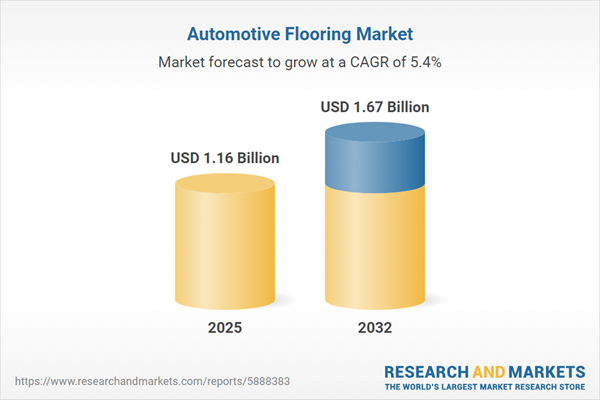Speak directly to the analyst to clarify any post sales queries you may have.
The automotive flooring market is undergoing significant transformation, spurred by advances in material science and shifting industry demands. For senior leaders, understanding the interplay of innovation, regulatory pressures, and evolving supply chains is central to making informed strategic decisions in this dynamic environment.
Market Snapshot: Automotive Flooring Market Growth and Trends
The automotive flooring market grew from USD 1.10 billion in 2024 to USD 1.16 billion in 2025. It is expected to continue growing at a CAGR of 5.38%, reaching USD 1.67 billion by 2032.
This steady expansion reflects increasing demand for advanced underfoot solutions, the integration of sustainable materials, and a heightened focus on vehicle interior comfort and safety. The sector's evolution is closely tied to broader trends in automotive manufacturing, supply chain resilience, and emerging vehicle technologies.Scope & Segmentation: Covering Market Drivers and Structure
- Vehicle Types: Commercial vehicles (heavy and light), off road vehicles (agricultural, construction), passenger cars (hatchback, sedan, sport utility vehicle).
- Material Types: Carpet (chenille, cut pile, loop pile), rubber (natural, synthetic), thermoplastic elastomer, vinyl.
- Distribution Channels: Dealership, e-commerce, original equipment manufacturer, retail.
- Regions: Americas (North America, Latin America), Europe, Middle East & Africa (Europe, Middle East, Africa), Asia-Pacific (including China, India, Japan, Southeast Asia, Australia, and others).
- Key Technologies: Digital simulation and prototyping, automated cutting systems, sensor-embedded mats, antimicrobial treatments, sound-dampening technologies, life cycle assessment tools, and real-time quality monitoring.
- Leading Companies: FORVIA SA, Lear Corporation, Yanfeng Automotive Interiors Co., Ltd., Toyota Boshoku Corporation, Autoneum Holding AG, International Automotive Components Group Limited.
Key Takeaways for Senior Decision-Makers
- Material innovation is enabling manufacturers to balance durability, aesthetics, and sustainability – supporting lighter, more efficient vehicle designs while responding to stringent environmental standards.
- The convergence of digital manufacturing strategies and Industry 4.0 has shortened production cycles and unlocked new potential for personalization, enhancing both OEM and aftermarket offerings.
- Collaborative efforts across the supply chain—from raw material suppliers to automotive OEMs—drive compatibility improvements and cost efficiencies, sharpening competitive advantage.
- As electric and autonomous vehicle adoption rises, automotive flooring systems are being engineered for novel requirements such as integrated battery platforms and embedded sensors.
- Strategic alliances, acquisitions, and joint ventures have enabled leading players to expand portfolios, accelerate innovation, and offer differentiated turnkey flooring solutions.
- Sustainability imperatives and consumer interest in eco-friendly interiors continue to influence raw material selection and recycling initiatives across global markets.
Tariff Impact: Navigating the 2025 U.S. Policy Shift
The introduction of new United States tariffs in 2025 has triggered recalibration throughout the global automotive flooring supply chain. Manufacturers are adjusting sourcing models, expanding domestic capacity, and reinforcing partnerships with North American suppliers to mitigate import cost pressures. Logistics innovation and nearshoring are gaining popularity, while research into alternative, locally sourced materials has accelerated to reduce exposure to tariff fluctuations. Although these adaptations require initial capital outlays, they promise enhanced supply chain resilience and operational stability.
Methodology & Data Sources
This report utilizes a blend of qualitative interviews with industry veterans, OEM leaders, and material specialists alongside comprehensive quantitative analysis from production databases and regulatory filings. Insights have been validated by triangulating corporate reports, patent data, customs records, and expert panel reviews to ensure relevance and accuracy.
Why This Report Matters for Automotive Flooring Leaders
- Gain actionable visibility into key market drivers, disruptive innovations, and strategic opportunities in automotive flooring across major global regions.
- Benchmark your organization’s approach to digitalization, sustainability, and collaborative supply chain models against leading industry practices.
- Equip your executive team with data-driven insights required to navigate regulatory changes, material trends, and evolving vehicle designs in a rapidly changing market.
Conclusion
The automotive flooring sector is defined by rapid change, innovation, and a renewed emphasis on supply chain agility. By leveraging the trends and strategies outlined in this report, leaders can make informed choices that drive long-term competitive advantage and sustainable growth.
Additional Product Information:
- Purchase of this report includes 1 year online access with quarterly updates.
- This report can be updated on request. Please contact our Customer Experience team using the Ask a Question widget on our website.
Table of Contents
3. Executive Summary
4. Market Overview
7. Cumulative Impact of Artificial Intelligence 2025
Companies Mentioned
The companies profiled in this Automotive Flooring market report include:- FORVIA SA
- Lear Corporation
- Yanfeng Automotive Interiors Co., Ltd.
- Toyota Boshoku Corporation
- Autoneum Holding AG
- International Automotive Components Group Limited
Table Information
| Report Attribute | Details |
|---|---|
| No. of Pages | 193 |
| Published | October 2025 |
| Forecast Period | 2025 - 2032 |
| Estimated Market Value ( USD | $ 1.16 Billion |
| Forecasted Market Value ( USD | $ 1.67 Billion |
| Compound Annual Growth Rate | 5.3% |
| Regions Covered | Global |
| No. of Companies Mentioned | 7 |









